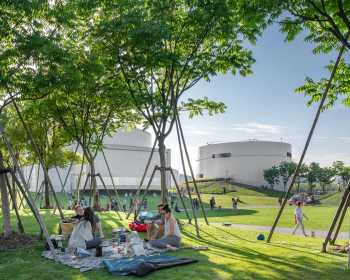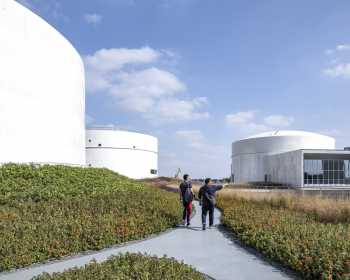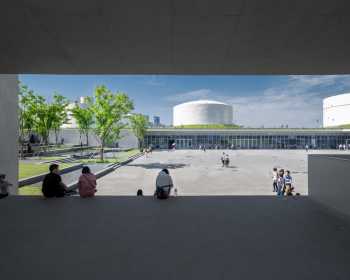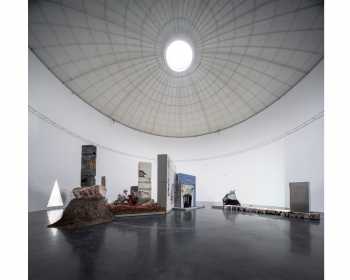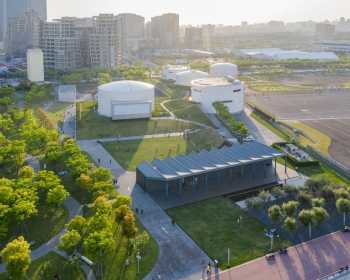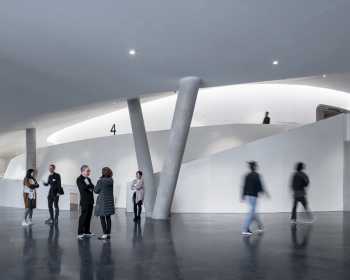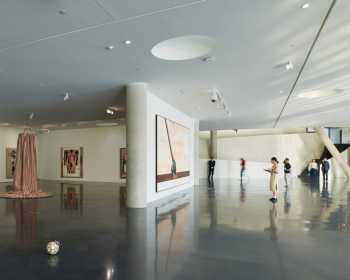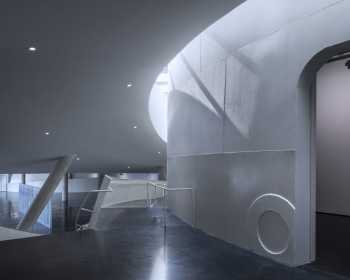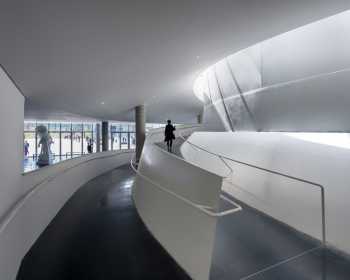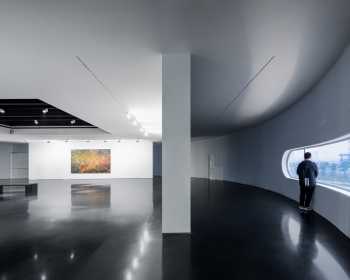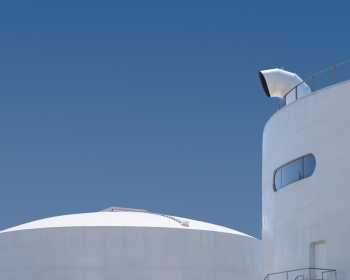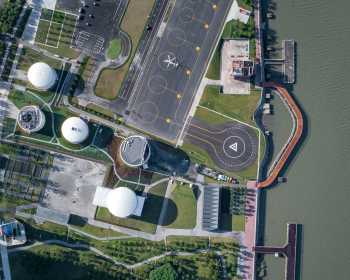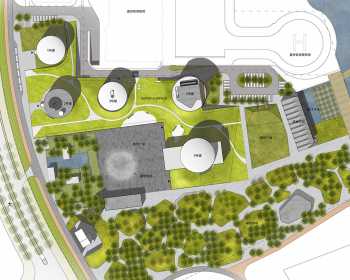Tank Shanghai
Along the banks of Shanghai's Huangpu River, five decommissioned aviation fuel tanks once stood abandoned on a dilapidated industrial site. Today, these tanks and the surrounding site—forgotten relics of the city's former Longhua Airport—have been given new life and relevancy. Over the course of six years, together with the newly created underground space that connects the tanks, and two separate gallery spaces dotted in the surrounding landscape, these iconic tanks were transformed from fuel containers into a vibrant new art and cultural center. Operated by the forward-thinking art institution which is also the project’s name sake, Tank Shanghai has already attracted millions of visitors since its opening in March 2019.
Conceived of as both an art center and an open park simultaneously, the project not only pays tribute to the site’s industrial past, but also seeks to dissolve the conventional perceptions of art institutions with formidable walls and definitive boundaries that separate the museum goers from those who are not. Tank Shanghai sets out to be an art center for all, and a museum without boundaries.
The design of the project purposefully rejects the idea of a bordered site. Long, sloping landscaped meadows down to and around each tank gallery offer open access to the street and riverside, inviting visitors and passersby to move freely between the city, nature, and art. Amidst the backdrop of Shanghai’s many more exclusive cultural projects, this gesture creates surprising—and rare—social inclusivity. Many come to the Tanks to view an art show, more come to jog or picnic, or simply to enjoy the undulating landscape with great view of the river. This open approach to the museum space has already brought about unexpected benefits and inspired new operational models for the art center. Within a year, Tank Shanghai has hosted not only high-profile art exhibitions but also many other non-conventional art related events, such as fashion week, book fair, art festival, and even an AI conference. By introducing new audiences to the traditionally closed-off space of the art center, Tank Shanghai has brought unprecedented energy to the formerly desolate industrial neighborhood.
Central to the project’s design is the merging of architecture and landscape through a Z-shaped “Super-Surface”—a five-hectare landscaped swath of trees and grasses which connects the five tanks and weaves different elements of the site together. The Super-Surface brings a number of both aesthetic and practical benefits to its riverside site, which shares a 115 meter-stretch of shoreline with the Huangpu River. The lush, thickly planted landscape creates a beautiful and urgently needed parkland in a city with just 17.56% green space, contributing to the rejuvenation of the area and the return of animal life in the city. Underneath the Super-Surface is the new construction of a large free-flowing open space that connects three out of five tanks from the underground level.
Visitors arriving from the street would descend a pebble path accompanied by a terraced waterscape toward the plaza, and then to the main entry, hardly realizing that now they are at underground level. Hidden misting devices create a cooling fog in the center of the plaza during summer times. At once poetic and practical, this circle of mist was designed to evoke the memory of a sixth tank which was torn down for the construction of the neighboring heliport, while at the same time improving the microclimate of the Plaza.
Flanking the south side of the plaza is an “Urban Forest” which provide much desired greenery and shades to the urban residents. Covering the eastern portion of the site, a second grassy plaza provides open space for outdoor events and leisure, and doubles as a standing room for audiences during music festivals. The Super-Surface is dotted with a collection of freely accessible public art installations.
We approached the design of each of the five tanks in response to the requirements of the different programs housed within them. Tank 1—a two-story pub with live music performances—has an added inner volume that is drum-shaped to improve the space’s acoustical quality. Tank 2—a restaurant—is organized around a circular central courtyard, and features a roof deck for alfresco dining. Tank 3 remains almost unchanged except for the addition of a central oculus and fireproofing to meet current life safety requirements, it offers a pantheon like domed space for large artworks and installations. The retractable skylight above the oculus may allow wind and rain to enter the gallery space if so desired – exactly what the artist chose to do for the opening show. Tank 4 contains a three-level cube that offers more conventional spaces for gallery and canvas art. Tank 5 features an inserted rectangular volume that passes through the body of the tank and emerges on either side to form two stages on both ends. From the exterior, the surface of all of the tanks preserve their original industrial aesthetics, only occasional capsule-shaped openings and portholes were added to bring light and view to the inside as needed.
Dispersed in the surrounding landscape are two separate smaller galleries: one is “Project Space” which was built with the exact same footprint of a demolished pump room on site, and the other is “Reflecting Gallery” which was designed in part to accommodate some municipal infrastructure control facilities. Wrapped in mirrored stainless-steel sheets, the Reflecting Gallery reflects the greenery around it and almost dissolves entirely into the Urban Forest. The multipurpose Project Space, overlooking the river and a tree-lined reflecting pool, features a saw-toothed roofline that deliberately juxtaposes the curvilinearity of the tanks. Across from it, the airport’s old firefighting pool now serves as a rectangular reflecting pond surrounded by olive trees.
Although the entire finished project enjoys a rather relaxed and easy-going atmosphere, the realization of the project was actually extremely challenging. The client and us collectively had to overcome many difficulties. To name a few, a cross-river vehicular tunnel passes diagonally right underneath the tank site, and the tunnel authority allows neither addition nor reduction of weight load on the deep soil layer above and around the tunnel; Immediately to the north of the site, a heliport was designed and built at the same time whose boundaries changed countless times and all bearing impacts on the tank project. If negotiating among the tunnel, aviation, port, park, and other governmental authorities are on one spectrum of the challenges, another spectrum was the structure of the old tanks themselves. The structure engineer allowed no new structure to be supported off the thick solid steel plates of the tanks, so both the Super Surface and all the new elements added inside the five tanks can only lightly ‘touch’ the tanks without adding any new loads to them.
Overall, Tank Shanghai represents a new type of urban art institution—one linking the past and the future, fusing art with nature, and more importantly, establishing meaningful connection between people and the place. With its unusual form and mission, we hope Tank Shanghai, the art center without boundaries, will continue to facilitate and inspire the creation of more inclusive and collective cultural spaces.
| Domus | Tank Shanghai call_made
| CNN Style | The husband-and-wife duo redefining cultural architecture in China call_made
| CNN | 'Post-weird': How Chinese architecture evolved in the Xi Jinping era call_made
| Architectural Journal | Tank Shanghai call_made
| T+A | Reconstructing the Surface call_made
| Architectural Record | Tank Shanghai call_made
| Wallpaper China | Forces of Nature call_made
| Fast Company | This Gorgeous Museum is Made from Old Jet Fuel Tanks call_made
| China Daily | An integration of design, nature and heritage call_made
| T Magazine | The Renaissance of Tanks call_made
| Dezeen | OPEN Architecture converts airport fuel tanks into gallery spaces call_made
| DesignBoom | In Shanghai, OPEN transforms aviation fuel tanks into 'containers of culture' call_made
| ArchDaily | OPEN Architecture's Art Park Opens in Shanghai Inside Old Fuel Tanks call_made
| Wallpaper | OPEN Architecture Transforms Airport Facilities into Tank Art Park in Shanghai call_made
| The New York Times | The New York Times' 2018 Arts Fall Preview call_made
Facts
Year:
Location: Shanghai, China
Floor area: 10,845
Site area: 56,920
Type: Architecture
Client: Shanghai West Bund Development Group + Tank Shanghai
Status: Completed
